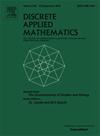3变量线性方程[1,…,n]的少量单色解的着色计算优化工具
IF 1
3区 数学
Q3 MATHEMATICS, APPLIED
引用次数: 0
摘要
算术拉姆齐理论中的一个著名结论是,对于许多线性齐次方程E,存在一个阈值Rk(E) (E的Rado数),使得对于区间[1,n]内任意整数的k-着色,且n≥Rk(E),存在至少一个单色解。但我们可以进一步问,用n表示的单色解的最小可能值是多少?在此,我们从整数和半定优化中提供了新的工具,帮助找到最优或接近最优的2-着色,并使几个3变量非正则齐次线性方程族的单色解的数量最小化。在论文的最后一部分,我们进一步将舒尔方程扩展到三种或更多的颜色,改进了之前的工作。本文章由计算机程序翻译,如有差异,请以英文原文为准。
Optimization tools for computing colorings of [1,…,n] with few monochromatic solutions on 3-variable linear equations
A famous result in arithmetic Ramsey theory says that for many linear homogeneous equations there is a threshold value (the Rado number of ) such that for any -coloring of the integers in the interval , with , there exists at least one monochromatic solution. But one can further ask, how many monochromatic solutions is the minimum possible in terms of ? Several authors have estimated this function before, here we offer new tools from integer and semidefinite optimization that help find either optimal or near optimal 2-colorings minimizing the number of monochromatic solutions of several families of 3-variable non-regular homogeneous linear equations. In the last part of the paper we further extend to three and more colors for the Schur equation, improving earlier work.
求助全文
通过发布文献求助,成功后即可免费获取论文全文。
去求助
来源期刊

Discrete Applied Mathematics
数学-应用数学
CiteScore
2.30
自引率
9.10%
发文量
422
审稿时长
4.5 months
期刊介绍:
The aim of Discrete Applied Mathematics is to bring together research papers in different areas of algorithmic and applicable discrete mathematics as well as applications of combinatorial mathematics to informatics and various areas of science and technology. Contributions presented to the journal can be research papers, short notes, surveys, and possibly research problems. The "Communications" section will be devoted to the fastest possible publication of recent research results that are checked and recommended for publication by a member of the Editorial Board. The journal will also publish a limited number of book announcements as well as proceedings of conferences. These proceedings will be fully refereed and adhere to the normal standards of the journal.
Potential authors are advised to view the journal and the open calls-for-papers of special issues before submitting their manuscripts. Only high-quality, original work that is within the scope of the journal or the targeted special issue will be considered.
 求助内容:
求助内容: 应助结果提醒方式:
应助结果提醒方式:


